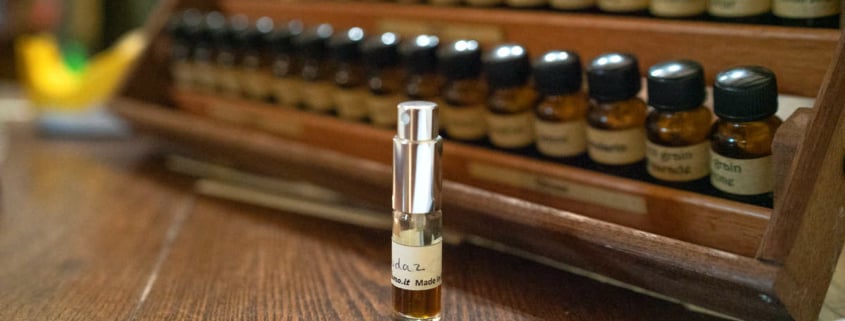How to make perfumes like a professional perfumer

Table of Contents
-
Understanding what is a perfume
-
The first step: Define the Idea
-
The second step: Define the Ingredients
-
The third step: Write the Formula
-
The fourth step: Execute the Formula
-
The fifth step: Control the Result
-
Conclusion
Understanding what is a perfume
The first error of non-professionals who make perfumes is thinking that perfumes are made with the nose. Consequently, they start composing a fragrance using their nose instead of using their brain.
In order to understand this, reflect that a smell is just a smell, while a perfume is more than a smell, it is a message expressed with smells.
Let us define the word “message”: A message is an idea expressed to others into words.
In nature, smells are the words of a universal olfactory language. You must know what you want to say with your perfume before putting the ingredients together, in the same way as you must know what you want to say in a message before putting the words together.
The starting point of a perfume is always an idea, at the end of the process, the perfume becomes the idea expressed into a smell.
The perfumer will use his nose during this process, but only at the end, to control the result of what his mind has made, and to correct eventual proportions so that the message is clear.
A perfume is made in 5 steps. There are different ways to approach how to make a perfume, but the process is always the same for a professional perfumer. Five steps, and only the last one involves the nose.
The first step: Define the Idea
The idea is the first thing to define in a perfume. As Guerlain used to repeat to his students; “Have simple ideas”.
A simple idea is the most difficult thing to find for my students at the beginning because they have difficulty grabbing the concept of “idea” in connection with “perfume”. Their mental connection to “perfume” is “smell”.
Yet it is the simplest thing in the world, once they will have acquired the brain of a perfumer, a brain able to think with smells.
To explain it, read Luca Turin writing about perfumes. He translates a smell into ideas in order to describe it. This is the work of a writer.
The work of a perfumer is exactly the contrary. Translating ideas into smells.
Step 2: Define the Ingredients
There is a language innate in us to which we react instinctively and sometimes use intuitively. It is the olfactory language.
In the same way as we understand and react to the body language of others and as we also use it instinctively.
Once you study body language, the attitude of others becomes so clear to you, feeling it has been replaced by understanding it. In the second step, you can use body language in order to pilot others’ feelings towards you.
The same is true for olfactory language, when you study it what is instinctive becomes knowledge and you can use it to communicate to others what you choose of feelings and emotions.
The second step consists of choosing a number of ingredients that will be the words with which you will express your message.
When you want to write a message, you will choose the words for the meaning they carry, not because they sound nice together.
When you want to write your perfume, similarly you will choose the ingredients for the meaning they carry, because your perfume is a message.
Step 3: Write the Formula
Putting the ingredients together in proportions that you decide according to what will be central to your message. That will be your interpretation of the idea.
The formula will define the form that your message will have, what points you will emphasize in the articulated idea that a message is.
This is why when my students execute the same idea, all the perfumes are different.
Step 4: Execute the Formula
Guerlain used to repeat to his students, “Have simple ideas, execute them scrupulously”.
Scrupulousness is a professional quality that guarantees the quality of a work.
Step 5: Control the Result
This is the point where you will use your nose. You will discover what fragrance your perfumer brain has made, and eventually correct it.
There are basically only 2 occasions when a perfumer will use his nose in making a perfume.
Guerlain used to repeat to his students: “Have simple ideas, execute them scrupulously, and never compromise on quality.”
First, You will use your nose to choose the best quality ingredients because the goodness of your perfume will be directly proportionate to the goodness of your ingredients.
The second occasion is when you control the result of your mind-made perfume.
The criteria to evaluate the result are simple, the way to correct it as well, because you will fix the formula, and the formula built according to a simple method is simple to correct.
This is what my students learn during the 6 days in which they become perfumers.
Conclusion
Guy Robert is a maximum authority in the world of perfumery. He is the author of Madame Rochas, Caleche, Equipage, Gucci Parfum and Dioressence.
This is the transcript of his lecture to his colleagues at the British Society of Perfumers. He says:
“Making perfumes is easy”
This is literally true, and even truer when it comes to natural perfumery. My students become perfumers in 6 days. All you need is to learn a few things about natural essences, a method to build perfumes, to acquire the right mental attitude and to have a normally functioning nose.


